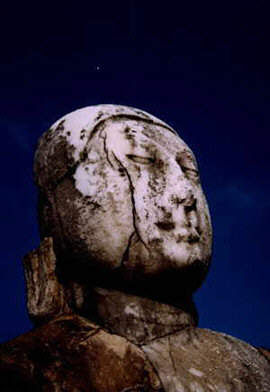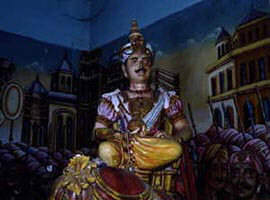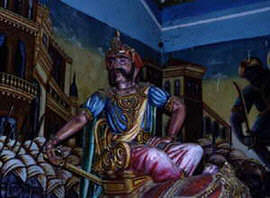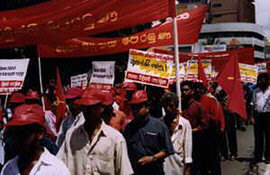 Introduction Introduction |
Even today, Sri Lanka is still known as Ceylon by some. While the name may bring up images of colonial times, it retains its cherished goodwill value. As an example, one of the country’s most important financial institutions remains the Bank of Ceylon. The Ceylon Electricity Board provides electricity services to modern Sri Lanka. There are enterprises like the Ceylon Fertilizer Company, the Ceylon Petroleum Corporation, Ceylon Silks and even the Ceylon Tourist Board.
Lanka was the name used from very early times. It is derived from a Sanskrit word-meaning island. It is used with reference to the island in such Indian classics as the Ramayana.
Ptolemy, an Egyptian geographer of the second century AD, recorded the Roman name as Taprobane, he also noted that the island produced rice, ginger, beryl and ivory. The name came from Thambapanni. For the origin of that name, reference to the Mahavamsa, which was written in Pali, reveals, "When those who were commanded by Vijaya landed there from their ship, they wearied, resting their hands on the ground. And since their hands were reddened by touching the dust of the red earth, that region and also the island was named Thambapanni (copper colored earth)."
Arab traders chose the name Serendib. Whenever that name is referred to it is linked with the word coined to describe the faculty for making happy and unexpected discoveries by accident: Serendipity. So apt for Sri Lanka.
It was the Dutch who adopted the Portuguese name of Ceilao as Ceylon. The British pronounced it as Ceylon and so the island eventually gave the world its best-known export, Pure Ceylon Tea. As Sri Lanka, the island is better known amongst the younger generation around the world for its cricket team. To anyone born after 1972, the name Ceylon is not even a memory.

 History History |
The first signs of human inhabitants in Sri Lanka date back to the Stone Age, about 1,750000 million years ago. These people are said to have come from the South of India and reached the Island through a land bridge connecting the Indian subcontinent to Sri Lanka named Adams Bridge. This is related so in the epic Hindu book of Ramayana.
 The Mauraya Empire The Mauraya Empire |

The arrival of the prince Vijayamarks sets the first historical record; this first records date back to the 5th century B.C. The arrival of the prince is chronicled in the book of Mahavansa and it relates how his father spelled the prince from India, following this the prince arrived in the Island conquering all three tribes that inhabited Sri Lanka at the time. This explains the ties of the Singhalese people to India whose language has common roots with that of the Northern tribes of India, Tamils the second largest ethnic group in the country have a language that shares a great deal with the Dravidian tribes of Southern India. More reliable historical information on the history of the island dates back to the 3rd century before Christ when the Mayura Empire of the neighbouring India incorporated Sri Lanka introducing the Buddhist faith that now dominates the religious environment of the country. It was during this period that Sri Lanka became known to Europeans as a land rich in gems and spices as related by Megasthenes to Alexander the great.
 A golden Age A golden Age |

In the year 65 AD the Vijaya Dynasty fell to control the Lambakannas who ruled the country for the next four centuries. It was at this time that the Island’s capital was moved to Anuradhapura and later on further to the South to prevent the frequent invasions from India.
| Polonnaruwa also became capital where a great civilization centred around a genius network of hydraulic engineering--the construction of water tanks (reservoirs) and irrigation canals, which allowed the city to heavily rely on artificial irrigation systems. But the constant feuding between rivalling tribes soon achieved the demise of the irrigation systems and in turn the kingdoms that had build it up. Then followed a time of internal conflicts that made the island an easy target for invaders. From 1247 to 1258 the island suffered raids from Malay pirates, in 1411 the Chinese admiral kidnapped a local king. Internal divisions and factional quarrels accomplished that by the 16th century the island was divided into three kingdoms, a Tamil kingdom in the North, the Kandy kingdom of the highlands and the Kotte kingdom situated in the South. In 1505 the island saw the arrival of the first colonialists, the Portuguese.
 The Portuguese The Portuguese |
Portugal was an aggressive expanding power all over the world between the 15th and early 16th century. In 1505, the fleet that reached the island was following the voyage of Vasco de Gamma, who had rounded the Cape of Good Hope in 1498 reaching India. The Portuguese were after the spices of the East. They tapped into the sophisticated system that was already in place, and became involved in local politics and struggles for power. Their relationship with the local kings was first of trading but soon turned in the direction of aiding the local kings in fighting the neighbouring kingdoms that threatened the island integrity.
Their main interest was the trading of cinnamon, ginger, nutmeg and pepper. Along with their commercial aspirations, they also introduced Christianity, the conversion of Prince Dharmapala in 1557 meant controlling the country to an even greater extend.
In 1543 the Portuguese took control of Kotte and the coastline through an agreement to defend Sri Lanka as a return tribute for cinnamon harvest.
 The Dutch The Dutch |
The Dutch came to power in Sri Lanka by aliening themselves with the Kandy kings who sought their help in spelling the Portuguese from the Island. This only resulted in the exchange of one colonial power for another. Their interest in the island lay in the trading of spices, and as a stopping point in their trading routes with the Far East, China, Japan and the Indies. In the 18th century when Dutch power declined, their colonies overseas became natural targets for stronger colonial powers such as Britain.
 British Rule British Rule |
The British were the only European power that managed to bring the Kandy kingdom under their control, which gave them access to the whole Island. In 1832, a massive inflow of colonists from the British island took over most of the land ownership of Sri Lanka, and set out to change the nature of the Island. As in India, they really changed the whole structure of the country and abolish slavery. The British allowed Sinhalese to participate in government with the intension of regenerating the Sri Lanka society on European lines. The introduction of coffee crops was the main thrust to the economy. A large number of Tamils were brought in from Southern India to work in the plantation since the Sinhalese were unwilling to work for such low wages. An epidemic that affected the coffee crop forced plantation owners to switch to tea. It was at this time that rubber was introduced as the main crop in the Island. In 1915 there were numerous riots and up-rises, which were suppressed by force. This was followed by concessions to nationalist demands. In 1919, the Ceylon national congress was created, which united Sinhalese and Tamil organization to obtain Independence from British rule. Sri Lanka’s first constitution was written in 1920, and amended in 1924. Later on in 1931 further constitutional changes were implemented allowing Sinhalese and Tamils to further extend their influence in government. In 1945 the Soulbury Commission would grant Sri Lanka its independence, which was achieved on 4th February 1948.
 Post-Independence period Post-Independence period |

Don Stephen Senanayake, leader of the United National Party, won the first elections in Sri Lanka. An elite dominated the UNP, mostly heterogeneous. The party did not respond to the needs of most of the population. In 1956 elections had the SLFP as the winning party. The SLFP had strong nationalist ideals that sided with the Sinhalese majority; Sinhala was made the official language along with moves to deport the whole Tamil population back to India. The result was complete outrage among the Tamil minority. This can be considered the beginning of the ethnic conflict that exists to this day in the country. In 1972 the Island was re-named Sri Lanka. And a new constitution was created. Sinhala remained the official language.
In 1977 the UNP regained power changing the constitution to the one from the old days of British colonialism in which an executive President was in charge. The first President of this new base mode was Junius Richard Jayawardena. In 1983 a series of anti Tamil riots all over the Island, particularly in Colombo, marked the start of hostilities between Tamils and Sinhalese. The violence escalated in 1987 and an Indian peace keeping force was deployed in the Northern part of the country to defuse the conflict. Violence has continued until October 1997 when President Chandrika Bandaranaike Kumarantunge announced a power sharing initiative directed at ending the conflict, which has lasted for over 25 years. The result of this power sharing initiative would grant Tamil dominated areas almost complete autonomy. The LTTE responded with a bomb blast in Colombo that killed 15 people and injured more than a hundred. Though the LTTE does not target foreigners there is travel advisories towards the North of the country and much of the East coast since they are restricted areas. |

